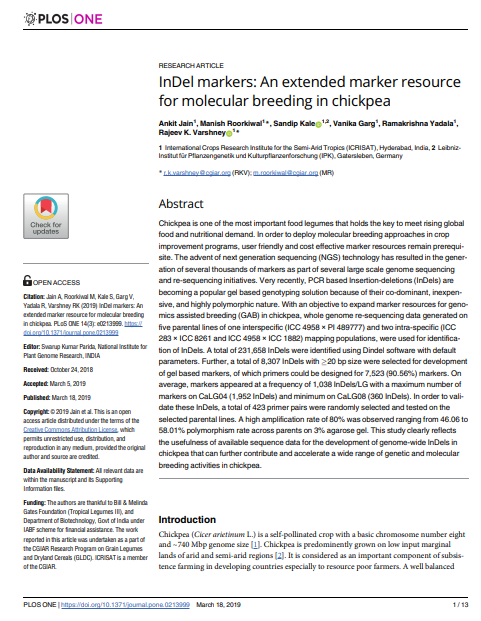InDel markers: An extended marker resource for molecular breeding in chickpea
Summary
Chickpea is one of the most important food legumes and holds the key to meeting rising global food and nutritional demand. In order to deploy molecular breeding approaches in crop improvement programs, user-friendly and cost-effective marker resources remain a prerequisite. The advent of next generation sequencing (NGS) technology has resulted in the generation of several thousands of markers as part of several large-scale genome sequencing and re-sequencing initiatives. Very recently, PCR based Insertion-deletions (InDels) are becoming a popular gel-based genotyping solution because of their co-dominant, inexpensive, and highly polymorphic nature. With an objective to expand marker resources for genomics assisted breeding (GAB) in chickpea, whole genome re-sequencing data generated on five parental lines of one interspecific (ICC 4958 × PI 489777) and two intra-specific (ICC 283 × ICC 8261 and ICC 4958 × ICC 1882) mapping populations were used for identification of InDels. A total of 231,658 InDels were identified using Dindel software with default parameters. Further, a total of 8,307 InDels with ≥20 bp size were selected for development of gel-based markers, of which primers could be designed for 7,523 (90.56%) markers. On average, markers appeared at a frequency of 1,038 InDels/LG with a maximum number of markers on CaLG04 (1,952 InDels) and minimum on CaLG08 (360 InDels). In order to validate these InDels, a total of 423 primer pairs were randomly selected and tested on the selected parental lines. A high amplification rate of 80% was observed ranging from 46.06 to 58.01% polymorphism rate across parents on 3% agarose gel. This study clearly reflects the usefulness of available sequence data for the development of genome-wide InDels in chickpea that can further contribute and accelerate a wide range of genetic and molecular breeding activities in chickpea.
Open resource Download resource Access resource on external site

